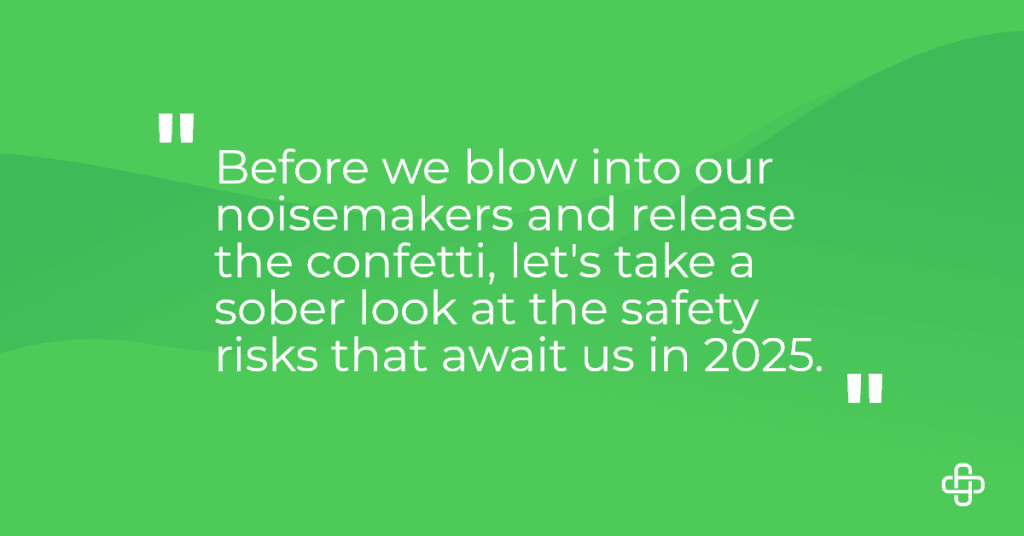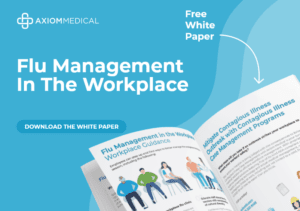Calendar days are flying by, and 2025 is just around the corner. But before we blow into our noisemakers and release the confetti, let’s take a sober look at the safety risks that await us in 2025.
The core principles of workplace safety will remain steadfast, so it’s not quite “out with the old, in with the new.” Yet, staying safe isn’t just about maintaining the status quo— each new year introduces unique challenges that demand our vigilance.

Here are five critical workplace safety objectives to help ensure a safer, more secure 2025 for everyone:
| Make Extreme Weather Preparedness Second Nature |
| Know That the Next “Achoo!” Could Be Bird Flu |
| Keep Experienced Employees on Their Feet (by Preventing Aging-Related Incidents) |
| Become a Mental Health MVP by Championing Employee Well-Being |
| Defend Against Data Breaches, One Click at a Time |
1. Make Extreme Weather Preparedness Second Nature
Flooding, wildfires, hurricanes, intense heat, landslides, and severe storms were frequent visitors in 2024. Current trends indicate that these extreme events will strike even harder in 2025. Preparing now could save lives, protect workplaces, and ensure smoother operations when nature does its worst.
You likely already know the main culprits in your area. But what about the lesser-known threats? Ignoring these emerging risks could leave your organization vulnerable. For instance, areas not historically prone to flooding may now face rising water levels due to shifting climate patterns. Stay one step ahead by mapping out comprehensive risk assessments and then solidifying plans for each possible extreme climate event.
And don’t plan in isolation. Partnering with local authorities and emergency services can enhance your organization’s preparedness. Governments often have resources like flood maps and wildfire risk assessments that can help you fine-tune your strategies. Collaborative training sessions with emergency personnel can further align corporate and community efforts, creating a stronger safety net for human life and protecting property.
2. Know That the Next “Achoo!” Could Be Bird Flu
Post-pandemic fatigue from coronavirus has muted the alarm signals for H5N1 Avian Influenza, popularly known as bird flu. It may be flying under the radar, but animal-to-human transmission has been recorded from Oahu to Vancouver and has a fatality rate of 50%. There have yet to be any signs of human-to-human transmission.
But we’re only a mutation away from that changing, which would mean we have a new pandemic on our hands. Preparedness for this possibility is, and will likely remain, low both nationally and internationally.
Luckily, Covid-19 gave us all a recent crash-course in reducing viral threats. So be sure to maintain best practices from that time so your team doesn’t get rusty. Encourage handwashing and enhance cleaning protocols by disinfecting shared surfaces in the workplace. To reduce airborne transmission, make sure HVAC systems are up-to-date and install air purifiers wherever possible to mitigate airborne pathogens. Lastly, encourage your employees to eat healthily and exercise regularly. Even if bird flu doesn’t take hold (talons crossed), these precautions will keep your organization healthy during the holiday season and beyond.
3. Keep Experienced Employees on Their Feet (by Preventing Aging-Related Incidents)
There’s no way around it: we’re all getting older this year. This inevitable march of time applies to our teams as well. The data shows that the share of older employees has increased across industries. Aging teams have a wealth of experience to draw from and are often highly engaged in their work. But to better support these employees, we need to prepare for physical challenges unique to this subset of workers.
Aging is risky business. As our bodies mature, our balance decreases, which increases our risk of slips and falls. Our muscle and bone mass also decreases, which increases our risk for muscle strains and broken or fractured bones during these falls. To add insult to these possible injuries, our recovery times often slow down as we get older.
To further support aging workers in 2025, implement targeted fall prevention programs with better lighting, non-slip surfaces, and safety railings in high-risk areas. Pay more attention to ergonomics. Encourage employees of all ages to take a proactive approach to their health by getting regular health screenings to identify potential issues early. Implementing these measures not only enhances safety but also demonstrates a commitment to valuing experienced employees.
4. Become a Mental Health MVP by Championing Employee Well-Being
Mental health challenges have been on the rise. Nearly one in five adults experience a mental health condition each year. Why that’s the case is up for debate, but it’s likely a combination of heightened societal stressors and lowered stigma around mental health. In 2025, we can expect mental health support to be a critical objective for maintaining teams’ overall health.
Besides encouraging employees to live healthy lifestyles and make use of any mental health services that may be offered, employers should do their best to create a supportive culture. Mental health issues can be subtle and difficult to recognize, especially in the workplace, so the best thing that employers can do is create close relationships with their reports and regularly check in with them.
Doing your part to create a culture of resilience in the workplace can be a great tool for building resilience and protecting employees from burnout. These efforts contribute to higher employee satisfaction, lower turnover rates, and a reputation as a company that genuinely cares for its people. Mental health symptoms will likely affect at least one member of your team this year, so taking proactive steps now will ensure employees remain productive, motivated, and engaged during 2025.
5. Defend Against Data Breaches, One Click at a Time
Digital systems are now the beating heart of most organizations’ processes. They’ve made our workplaces more efficient and safer, but they also come with a host of dangers. One key concern often overlooked is how data breaches can physically endanger workers. Cyberattacks can cause machinery to malfunction, safety monitoring systems to fail, and create general disruption and chaos.
To address these escalating threats, employers must prioritize cybersecurity as much as physical safety protocols. Employers can strengthen their systems by implementing advanced firewalls, regular systems updates, and real-time monitoring to detect breaches early. Taking steps to minimize the impact of breaches is a smart idea as well, so be sure to encrypt sensitive information and maintain regular data backups. And since cybersecurity awareness at all levels is critical, make sure employees are roped into these precautions too. Ensure that they have strong password hygiene and are savvy to phishing attempts.
The operational disruptions caused by compromised systems can be very hazardous. Investing in cybersecurity in 2025 isn’t just about protecting systems—it’s about protecting people.
Better Safe Than Sorry
It’s impossible to predict every danger, but taking a proactive stance toward emerging risks can protect everyone on the team. When push comes to shove, employers will be glad they took precautionary measures. As Chinese philosopher Lao Tzu once said, “there is no greater wrong than preparing to defend yourself.”
For now, let’s start with something simple: your seat. Watch our recent webinar Next-Level Ergonomics: Advanced Program to Transform Workplace Health with Ergonomist Dr. P Shakeel Marley, PT, DPT and Chief Medical Officer Dr. Scott Cherry.

Cain Boney is a contributor to Axiom Medical’s blog. With a career dedicated to writing about the workplace, Cain focuses on how employee well-being affects organizational success and sustainability in the long term.










